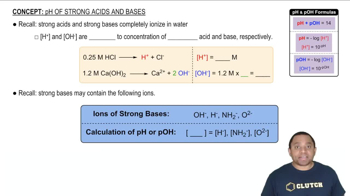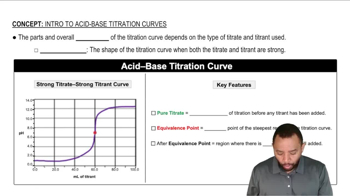Consider the titration of a 25.0-mL sample of 0.115 M RbOH with 0.100 M HCl. Determine each quantity. b. the volume of added acid required to reach the equivalence point
Ch.17 - Aqueous Ionic Equilibrium
Chapter 17, Problem 72
A 30.0-mL sample of 0.165 M propanoic acid is titrated with 0.300 M KOH. Calculate the pH at each volume of added base: 0 mL, 5 mL, 10 mL, equivalence point, one-half equivalence point, 20 mL, 25 mL. Sketch the titration curve.

 Verified step by step guidance
Verified step by step guidance1
Step 1: Calculate the initial moles of propanoic acid (C2H5COOH) using the formula: moles = Molarity × Volume.
Step 2: For each volume of KOH added, calculate the moles of KOH added using the formula: moles = Molarity × Volume.
Step 3: Determine the moles of propanoic acid and its conjugate base (propanoate ion, C2H5COO-) after the reaction with KOH using stoichiometry.
Step 4: Use the Henderson-Hasselbalch equation to calculate the pH at each point where the buffer region is applicable: pH = pKa + log([A-]/[HA]).
Step 5: For the equivalence point and beyond, calculate the pH based on the concentration of the excess strong base (KOH) in the solution.

Verified video answer for a similar problem:
This video solution was recommended by our tutors as helpful for the problem above.
Video duration:
20mWas this helpful?
Key Concepts
Here are the essential concepts you must grasp in order to answer the question correctly.
Titration
Titration is a quantitative analytical technique used to determine the concentration of a solute in a solution. It involves the gradual addition of a titrant (in this case, KOH) to a solution of the analyte (propanoic acid) until the reaction reaches its equivalence point, where the amount of titrant added is stoichiometrically equivalent to the amount of substance in the analyte.
Recommended video:
Guided course

Acid-Base Titration
pH and Acid-Base Neutralization
pH is a measure of the acidity or basicity of a solution, with lower values indicating acidic conditions and higher values indicating basic conditions. During a titration of a weak acid like propanoic acid with a strong base like KOH, the pH changes significantly, especially around the equivalence point, where the acid is completely neutralized, resulting in a sharp increase in pH.
Recommended video:
Guided course

pH of Strong Acids and Bases
Titration Curve
A titration curve is a graphical representation of the pH of a solution as a function of the volume of titrant added. It typically shows a gradual increase in pH at first, followed by a steep rise near the equivalence point, and then levels off. The shape of the curve provides insights into the strength of the acid and base involved, as well as the equivalence and half-equivalence points.
Recommended video:
Guided course

Acid-Base Titration Curves
Related Practice
Textbook Question
Textbook Question
Consider the titration of a 25.0-mL sample of 0.115 M RbOH with 0.100 M HCl. Determine each quantity. c. the pH at 5.0 mL of added acid
Textbook Question
Consider the titration of a 20.0-mL sample of 0.105 M HC2H3O2 with 0.125 M NaOH. Determine each quantity. b. the volume of added base required to reach the equivalence point
Textbook Question
A 30.0-mL sample of 0.165 M propanoic acid is titrated with 0.300 M KOH. Calculate the pH at each volume of added base: 0 mL.
Textbook Question
A 30.0-mL sample of 0.165 M propanoic acid is titrated with 0.300 M KOH. Calculate the pH at each volume of added base: 5 mL.
Textbook Question
A 30.0-mL sample of 0.165 M propanoic acid is titrated with 0.300 M KOH. Calculate the pH at each volume of added base: 10 mL.
